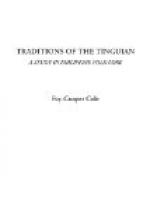The few references to the procedure immediately after a death indicate that, in part, the people of to-day follow the old custom; but here again an important departure occurs. We are thrice told that the corpse was placed on a little raft called tabalang and set adrift on the river; and in one case the afterbirth was treated in the same manner. Nothing of the sort is done to-day, nor does it seem at all likely that such has been the case in recent generations. The body is now buried beneath the house, and certain set rules govern the movements of all persons related to the deceased, as well as the disposal of the corpse. This procedure is so complex and so uniform throughout the whole Tinguian belt that it seems improbable that it has grown up, except through a long period of time. At this point it is interesting to note that at many ceremonies it is necessary to construct a small raft called tal-talababong, or talabong, to place offerings in it, and set it adrift on the stream, in order that any spirits who have been prevented from attending the ceremony may still secure their share. [59]
The festivals, the dances, the observances of the proprieties required by good breeding or custom of to-day, follow closely those given in the tales. The greatest divergence is in the offering of betel-nuts and the telling of names, which occupies such an important place in the narratives. The use of betel-nut for chewing is less common among the Tinguian people than with most other Philippine tribes, a fact which may be accounted for by their constant use of tobacco. However, betel-nuts still occupy a most important place in the various ceremonies, and many offerings intended for the spirits must be accompanied with the prepared nut. In nearly every instance when invitations were sent out, for a ceremony, the people of the tales intrusted an oiled betel-nut covered with gold with this duty. This has its counterpart to-day in the small gifts of gold which are often carried to some friend, in another town, whose presence is particularly desired. It seems not improbable that the golden colored husks of the ripe betel-nuts may have suggested the substitution.
Magic was practiced extensively in “the first time,” but it is by no means unknown to the people of the present day. They cannot now bring a dead person to life, or create human beings out of bits of betel-nut; but they can and do cause sickness and death to their foes by performing certain rites or directing actions against garments or other objects recently in their possession. Even the name of an enemy can be applied to an animal or inanimate object and action against it be transferred to the owner.
Like the Tinguian, the people of Kadalayapan and Kaodanan are warned or encouraged by omens received through the medium of birds, thunder, lightning, or the condition of the gall and liver of a slaughtered pig; [60] and like them they suffer for failure to heed these warnings, or for the infraction of a taboo.




